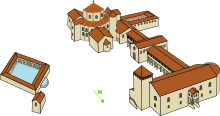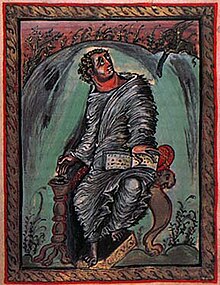Pre-Romanesque art and architecture
This article needs additional citations for verification. (January 2015) |


Pre-Romanesque art and architecture is the period in European art from either, the emergence of the Merovingian kingdom in about 500 AD or from the Carolingian Renaissance in the late 8th century, to the beginning of the 11th century Romanesque period. The term is generally used in English only for architecture and monumental sculpture, but here all the arts of the period are briefly described.
The primary theme during this period is the introduction and absorption of
In most of western Europe, the
The unification of the Frankish kingdom under
Many Merovingian plans have been reconstructed from archaeology. The description in Bishop Gregory of Tours' History of the Franks of the basilica of Saint-Martin, built at Tours by Saint Perpetuus (bishop 460–490) at the beginning of the period and at the time on the edge of Frankish territory, gives cause to regret the disappearance of this building, one of the most beautiful Merovingian churches, which he says had 120 marble columns, towers at the East end, and several mosaics: "Saint-Martin displayed the vertical emphasis, and the combination of block-units forming a complex internal space and the correspondingly rich external silhouette, which were to be the hallmarks of the Romanesque".[2]
The Merovingian dynasty were replaced by the Carolingian dynasty in 752 AD, which led to Carolingian architecture from 780 to 900, and Ottonian architecture in the Holy Roman Empire from the mid-10th century until the mid-11th century. These successive Frankish dynasties were large contributors to Romanesque architecture.
Examples of Frankish buildings



- Baptistère de Riez built in the 4th, 5th and 7th centuries
- Fréjus Cathedral circa 450 AD
- Crypt of Saint-Laurent Grenoble circa 500
- Merovingians
- Baptistère Saint-Jean 507
- Baptistère de Venasque circa 500
- Abbey of Saint-Germain-des-Préscirca 540
- Radegonde de Poitiers Tomb of St. Radegunda 587
- Jouarre Abbey 630, Merovingian crypt
- Kloster Reichenau 724
- Benedictine Convent of Saint John, Müstair 780
- Granusturm 788, 20-meter-tall tower in Aarchen
- Lorsch Abbey, gateway, (c. 800)
- Palatine Chapel in Aachen(Aix-la-Chapelle) (792–805)
- Imperial Palace, Ingelheim800
- Oratory of Bishop Theodulf of Orleans in Germigny-des-Prés806
- St. Ursmar's Collegiate church, in Lobbes, Belgium (819–823)
- St. Michael, Fulda, rotunda and crypt (822)
- Einhard's Basilica, Steinbach (827)
- Saint Justinus' church, Frankfurt-Höchst(830)
- Hildesheim Cathedral, original build (872)
- Schloss Broich 883–884, Carolingian fortress
- Broich Castle, Muelheim on the Ruhr (884)
- Abbey of Corvey(885)
- St. George, Oberzell in Reichenau Island (888)
- St. Georg (Reichenau-Oberzell) 900
- St. Johannis (Mainz) 910
- Church of St Philibert, Tournus950
- St. Cyriakus, Gernrode969
Ottonian and Holy Roman Empire
- Mainz Cathedral begun 991 and 994 and retains some structure of this period.
- St. Michael's Church Hildesheim, 1031
Imperial styles
Carolingian art

Carolingian art is the roughly 120-year period from about 780 to 900, during
Ottonian art
After the decline of the Carolingian Empire, the Holy Roman Empire was re-established under the Saxon (Ottonian) dynasty. From this emerged a renewed faith in the idea of Empire and a reformed Church, creating a period of heightened cultural and artistic fervour. It was in this atmosphere that masterpieces were created that fused the traditions from which Ottonian artists derived their inspiration: models of Late Antique, Carolingian, and Byzantine origin.
Much Ottonian art reflected the dynasty's desire to establish visually a link to the Christian rulers of Late Antiquity, such as
Ottonian monasteries produced some of the most magnificent medieval illuminated manuscripts. They were a major art form of the time, and monasteries received direct sponsorship from emperors and bishops, having the best in equipment and talent available.
Regional styles
British Isles
Prior to King Alfred the dominant art style in England was the
Croatia

In the 7th century the Croats, with other Slavs and Avars, came from Northern Europe to the region where they live today.[3] The first Croatian churches were built as royal sanctuaries, and the influence of Roman art was strongest in Dalmatia where urbanization was thickest. Gradually that influence was neglected and certain simplifications and alterations of inherited forms, and even creation of original buildings, appeared.
All of them (a dozen large ones and hundreds of small ones) were built with roughly cut stone bounded with a thick layer of mortar on the outside. Large churches are longitudinal with one or three
From the Crown Church of
By joining the Hungarian crown in the twelfth century, Croatia lost its full independence, but it did not lose its ties with the south and the west, and instead this ensured the beginning of a new era of Central European cultural influence.
France
After the demise of the Carolingian Empire, France split into a number of feuding provinces, so that lacking any organized Imperial patronage, French art of the 10th and 11th centuries became localised around the large monasteries, and lacked the sophistication of a court-directed style.
Multiple regional styles developed based on the chance availability of Carolingian manuscripts (as models to draw from), and the availability of itinerant artists. The monastery of
Italy
Southern Italy benefited from the presence and cross-fertilization of the Byzantines, the Arabs, and the Normans, while the north was mostly controlled first by the Carolingians. The
Spain and Portugal
The first form of Pre-Romanesque in
After the Moorish occupation, Pre-Romanesque art was first reduced to the
The best preserved Visigothic monument in
See also
References
- ^ "History of Art:Barbarian Art".
- ISBN 0-85331-487-X
- ^ "[Projekat Rastko] Valentin V. Sedov: Slavs in the Early Middle Ages". Archived from the original on 2013-11-11. Retrieved 2010-03-25.
- Joachim E. Gaehde (1989). "Pre-Romanesque Art". ISBN 0-684-18276-9
- Jacques Fontaine (1995) L'art pré-roman hispanique, Nuit des temps, ISBN 2-7369-0215-7
